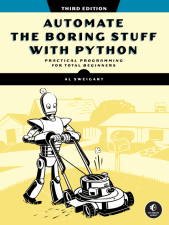
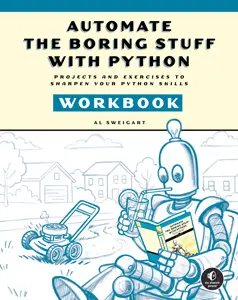
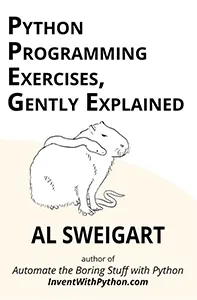
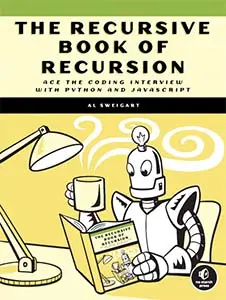
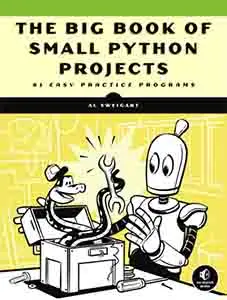
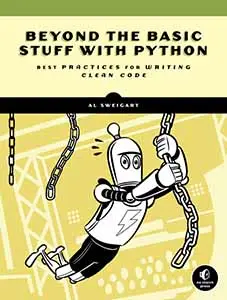
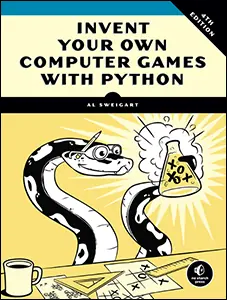
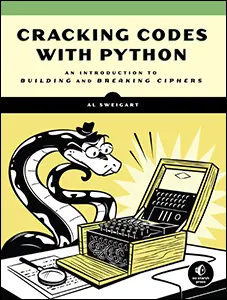
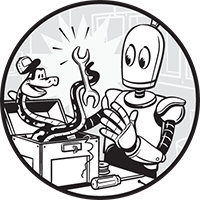
Deoxyribonucleic acid is a tiny molecule that exists in every cell of our bodies and contains the blueprint for how our bodies grow. It looks like a double helix (a sort of twisted ladder) of pairs of nucleotide molecules: guanine, cytosine, adenine, and thymine. These are represented by the letters G, C, A, and T. DNA is a long molecule; it’s microscopic, but if it were stretched out, its 3 billion base pairs would be 2 meters long! This program is a simple animation of DNA.
When you run dna.py, the output will look like this:
DNA Animation, by Al Sweigart [email protected]
Press Ctrl-C to quit...
#G-C#
#C---G#
#T-----A#
#T------A#
#A------T#
#G-----C#
#G---C#
#C-G#
##
#T-A#
#C---G#
#G-----C#
#G------C#
#T------A#
#A-----T#
#C---G#
#G-C#
##
#T-A#
#T---A#
#A-----T#
--snip--Similar to Project 15, “Deep Cave,” and Project 20, “Digital Stream,” this program creates a scrolling animation by printing strings from the ROWS list. The AT and CG pairs are inserted into each string with the format() string method.
1. """DNA, by Al Sweigart [email protected]
2. A simple animation of a DNA double-helix. Press Ctrl-C to stop.
3. Inspired by matoken https://asciinema.org/a/155441
4. View this code at https://nostarch.com/big-book-small-python-projects
5. Tags: short, artistic, scrolling, science"""
6.
7. import random, sys, time
8.
9. PAUSE = 0.15 # (!) Try changing this to 0.5 or 0.0.
10.
11. # These are the individual rows of the DNA animation:
12. ROWS = [
13. #123456789 <- Use this to measure the number of spaces:
14. ' ##', # Index 0 has no {}.
15. ' #{}-{}#',
16. ' #{}---{}#',
17. ' #{}-----{}#',
18. ' #{}------{}#',
19. ' #{}------{}#',
20. ' #{}-----{}#',
21. ' #{}---{}#',
22. ' #{}-{}#',
23. ' ##', # Index 9 has no {}.
24. ' #{}-{}#',
25. ' #{}---{}#',
26. ' #{}-----{}#',
27. ' #{}------{}#',
28. ' #{}------{}#',
29. ' #{}-----{}#',
30. ' #{}---{}#',
31. ' #{}-{}#']
32. #123456789 <- Use this to measure the number of spaces:
33.
34. try:
35. print('DNA Animation, by Al Sweigart [email protected]')
36. print('Press Ctrl-C to quit...')
37. time.sleep(2)
38. rowIndex = 0
39.
40. while True: # Main program loop.
41. # Increment rowIndex to draw next row:
42. rowIndex = rowIndex + 1
43. if rowIndex == len(ROWS):
44. rowIndex = 0
45.
46. # Row indexes 0 and 9 don't have nucleotides:
47. if rowIndex == 0 or rowIndex == 9:
48. print(ROWS[rowIndex])
49. continue
50.
51. # Select random nucleotide pairs, guanine-cytosine and
52. # adenine-thymine:
53. randomSelection = random.randint(1, 4)
54. if randomSelection == 1:
55. leftNucleotide, rightNucleotide = 'A', 'T'
56. elif randomSelection == 2:
57. leftNucleotide, rightNucleotide = 'T', 'A'
58. elif randomSelection == 3:
59. leftNucleotide, rightNucleotide = 'C', 'G'
60. elif randomSelection == 4:
61. leftNucleotide, rightNucleotide = 'G', 'C'
62.
63. # Print the row.
64. print(ROWS[rowIndex].format(leftNucleotide, rightNucleotide))
65. time.sleep(PAUSE) # Add a slight pause.
66. except KeyboardInterrupt:
67. sys.exit() # When Ctrl-C is pressed, end the program.Try to find the answers to the following questions. Experiment with some modifications to the code and rerun the program to see what effect the changes have.
rowIndex = rowIndex + 1 on line 42 to rowIndex = rowIndex + 2?random.randint(1, 4) on line 53 to random.randint(1, 2)?PAUSE = 0.15 on line 9 to PAUSE = -0.15?